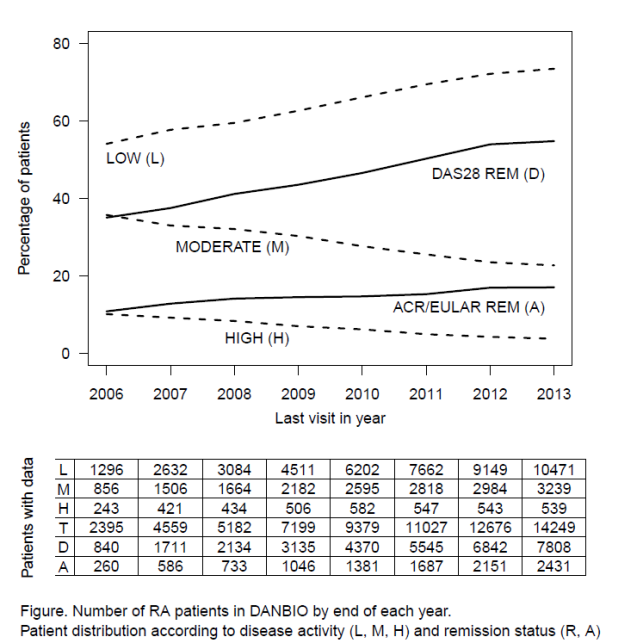Session Information
Session Type: Abstract Submissions (ACR)
Background/Purpose:
Monitoring patients with rheumatoid arthritis (RA) in clinical practice with regular assessment of disease activity (e.g. DAS28) is recommended as a part of a treat-to-target strategy, but little is known about its feasibility. In Denmark, prospective, nationwide collection of data on patients with RA in routine care has been conducted in the DANBIO database since year 2006 (1). We present the development over time in patient inclusion and disease control.
Methods:
DANBIO serves as an electronic patient file in routine care. Disease activity score (DAS28) is presented in colour, encouraging a treat-to-target strategy. Patients are followed twice yearly.
Results:
From Jan 1st 2006 to Dec 31st, 2013, the number of RA patients increased from 2,395 to 14,249 (age at time of inclusion: 60(50-59) (median(IQR)) years, 73% women, 87.2% IgM-RF positive, 54% erosive, disease duration 4 (0-11) years, HAQ 0.75(0.25-1.375), DAS28 3.9(2.7-5.1)).
By 2013, 9,054 patients were bDMARD naïve (MTX: 76%; other csDMARD: 21%), 4,254 pts received bDMARD (etanercept(28%) and adalimumab (21%) most prevalent; 66% in combination with MTX), and 941 pts had formerly received bDMARD.
In 2006, 54% of the 2,395 patients had low disease activity (DAS28<3.2) (figure). In 2013 it was 73% of 14,249 patients. For high disease activity it was 10% and 4%, respectively. The fraction of patients in DAS28 remission (DAS28<2.6) was 35% in 2006 and 55% in 2013. For ACR/EULAR remission it was 11% and 17%, respectively.
The prevalence of patients with RA in Denmark (which has ≈5.6 mill inhabitants) has in a medical technology review in 2002 been estimated to be ≈18,000 for patients who attend rheumatology clinics and departments, and ≈35,000 for patients with self-reported disease (2). By 2013, DANBIO’s coverage may thus be estimated to be 40%-79%. For the subgroup receiving bDMARD, coverage is 94% (3).
Conclusion:
By using an electronic platform, Danish rheumatologists included 40-79% of all RA patients into the DANBIO database during an 8 year period for prospective registration, thereby creating a data repository for quality improvement and research purposes with high external validity.
The demographic characteristics of the “real-life” cohort are typical for RA, and it covers all disease states regarding treatment, disability and disease activity. By 2013, 17% and 55% of patients were in ACR/EULAR remission and DAS28 remission, respectively, and 73% had low disease activity.
Thus, systematic monitoring of real-life RA patients with a treat-to-target strategy with real-time feedback to the physician is feasible, whereas the aim of treat-to-target is not achieved in a substantial proportion of patients in routine care.
(1) Hetland ML. Rheumatology 2011
(2) Sundhedsstyrelsen CfEoMT. Med teknologivurdering 2002.
(3) DANBIO Annual Report 2013 (www.danbio-online.dk)
Disclosure:
M. L. Hetland,
None;
D. V. Jensen,
None;
N. S. Krogh,
None.
« Back to 2014 ACR/ARHP Annual Meeting
ACR Meeting Abstracts - https://acrabstracts.org/abstract/monitoring-patients-with-rheumatoid-arthritis-in-routine-care-experiences-from-a-treat-to-target-strategy-using-the-danbio-registry/

